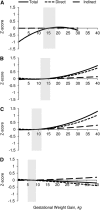Excess gestational weight gain is associated with child adiposity among mothers with normal and overweight prepregnancy weight status
- PMID: 22955516
- PMCID: PMC6498456
- DOI: 10.3945/jn.112.161158
Excess gestational weight gain is associated with child adiposity among mothers with normal and overweight prepregnancy weight status
Abstract
There are inconsistencies in the literature regarding the association between gestational weight gain (GWG) and child adiposity. GWG is hypothesized to act on child adiposity directly through intrauterine programming and indirectly through birth weight. It is unclear if the relative importance of these pathways differs by prepregnancy BMI status. We analyzed data from 3600 participants of the nationally representative Early Childhood Longitudinal Study-Birth Cohort. Child BMI Z-score was calculated from height and weight measured at 5 y. Using linear regression, controlling for sociodemographics and family lifestyle, we examined prepregnancy BMI-specific associations between GWG and child BMI Z-score. There was a nonlinear association among normal (P < 0.001) and overweight mothers only (P = 0.013), such that GWG beyond the midpoint of the 2009 Institute of Medicine recommendations was associated with a significant increase in child BMI Z-score. After the addition of birth-weight-for-gestational-age and breastfeeding to the model, the association remained among normal-weight mothers (P = 0.005) and was slightly attenuated among overweight mothers (P = 0.09). No significant association was observed between GWG and child BMI Z-score among underweight or obese mothers. We used path analysis to decompose the total effect into direct and indirect effects. This indicated the presence of a stronger direct than indirect effect. In conclusion, low GWG is not associated with BMI Z-score among any prepregnancy BMI group. Excess GWG is associated with an increase in child BMI Z-score among normal and overweight mothers only. Prevention of excess GWG may be a strategy to prevent childhood obesity.
Figures



References
-
- Institute of Medicine and NRC Weight gain during pregnancy: reexamining the guidelines. Washington, DC: The National Academies Press; 2009. - PubMed
-
- Ogden CL, Carroll M, Curtin L, Lamb M, Flegal K. Prevalence of high body mass index in US children and adolescents, 2007–2008. JAMA. 2010;303:242–9. - PubMed
-
- Oken E, Gillman M. Fetal origins of obesity. Obes Res. 2003;11:496–506. - PubMed
-
- Shaarawy M, el Mallah SY. Leptin and gestational weight gain: relation of maternal and cord blood leptin to birth weight. J Soc Gynecol Investig. 1999;6:70–3. - PubMed
Publication types
MeSH terms
Grants and funding
LinkOut - more resources
Full Text Sources
Medical

